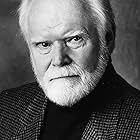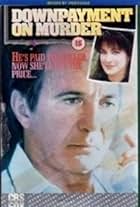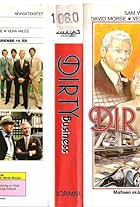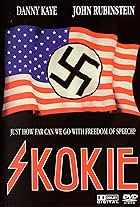CALIFICACIÓN DE IMDb
6.9/10
355
TU CALIFICACIÓN
Agrega una trama en tu idiomaStory of the rise and fall of 1920s' Ku Klux Klan leader D.C. Stephenson.Story of the rise and fall of 1920s' Ku Klux Klan leader D.C. Stephenson.Story of the rise and fall of 1920s' Ku Klux Klan leader D.C. Stephenson.
- Dirección
- Guionista
- Elenco
- Ganó 1 premio Primetime Emmy
- 1 premio ganado y 1 nominación en total
Tony Mockus Sr.
- Judge Sparks
- (as Tony Mockus)
- Dirección
- Guionista
- Todo el elenco y el equipo
- Producción, taquilla y más en IMDbPro
Opiniones destacadas
This actually isn't that bad of a movie, considering the fact that it... 1.) has no stars I have even really heard of, except for a few I don't care for. 2.) was not just a movie-of-the-week, but was a miniseries, which aired on my TV it's entirety (though I only saw most of the second part) and # 3.) is flawed by a few hokey parts, such as people cheering loudly in a courtroom.
But every movie has its flaws, and "Cross of Fire" actually had some good points as well. It covers the rise of Ku-Klux-Klan leader D. C "Steve" Stevenson, who eventually became so powerful in his town, that he could pretty much get away with doing whatever he wanted, or so he thought.
Now court cases appear frequently in these kinds of movies, and often the cases are much more dramatized than they would ever be in the real world. This case had it's dramatic moments, some of them touching, others quite silly, but hey, D. C Stevenson was supposed to be a prominent figure, so it wasn't totally off-the-wall. I also enjoyed Madge's lawyer-friend, who proved to be not the wimp everybody thought he was. I am not certain of the actor who played this fellow, but he was actually quite well-cast, as was Lloyd Bridges as Steve's veteran lawyer. Mel Harris, as Madge, was actually somewhat touching in her own sense, and the man who played Steve nailed down a pretty hateful character, who only rarely over-acted.
Well, while I don't exactly think I would watch "Cross of Fire" again and again, but it's rare when a miniseries is able to rise above the usual silliness. I'm not saying it's perfect, but it's...alright.
But every movie has its flaws, and "Cross of Fire" actually had some good points as well. It covers the rise of Ku-Klux-Klan leader D. C "Steve" Stevenson, who eventually became so powerful in his town, that he could pretty much get away with doing whatever he wanted, or so he thought.
Now court cases appear frequently in these kinds of movies, and often the cases are much more dramatized than they would ever be in the real world. This case had it's dramatic moments, some of them touching, others quite silly, but hey, D. C Stevenson was supposed to be a prominent figure, so it wasn't totally off-the-wall. I also enjoyed Madge's lawyer-friend, who proved to be not the wimp everybody thought he was. I am not certain of the actor who played this fellow, but he was actually quite well-cast, as was Lloyd Bridges as Steve's veteran lawyer. Mel Harris, as Madge, was actually somewhat touching in her own sense, and the man who played Steve nailed down a pretty hateful character, who only rarely over-acted.
Well, while I don't exactly think I would watch "Cross of Fire" again and again, but it's rare when a miniseries is able to rise above the usual silliness. I'm not saying it's perfect, but it's...alright.
6=G=
"Cross of Fire" tells the story of David C. Stephenson, a megalomaniac who rose to considerable power and notoriety as the head of the Indiana Ku Klux Klan in the early 1920's. A tour-de-force by Heard as Stephenson, this 3 hour journeyman miniseries moves along well laying out the biography and history during the first half and then bogs down in the middle, turning into a courtroom drama, as Stephenson is put on trial for murder. An okay watch for those interested in this footnote in American history which others may find a bit tedious.
Most three hour movies, other than classics like "The Good, the Bad, and the Ugly", tend to be so padded that they become tedious. I recommend "Cross of Fire'" as one of those rarities that maintains interest for the entire 185 minutes. John Heard gives a performance second only to his fantastic character "Alexander Cutter" in "Cutter's Way". This film is easily divided into two parts, the first with megalomaniac Heard rising to power within the Klu Klux Klan. The second, his trial for the rape and murder of an Indianopolis school teacher. The trial ultimately not only decides the fate of Heard, but of the Klan itself. - MERK
D.C.Stephenson was the stereotypical Alabama redneck who moved to Indiana and with his racist beliefs as his driving force formed the Hoosier chapter of the Ku Klux Klan. He used thugs to force local businessmen to join his "organization" (or he would wreck their businesses, livelihood and reputations). Stephenson purchased a large home in the east Indianapolis neighborhood of Irvington and had it remodeled to look like a southern plantation home, complete with tall columns in front. In an effort to make the KKK look like a "charitable organization" he funded the building of an orphanage, (which still stands as a school very near the then home of the Oberholzer family).
The acting is good in this film and is an effort to tell an important story about a bad chapter in our Nation's history, but IMHO not enough effort was made to show the details of how Klan money had purchased the favors and even membership of local politicians into the Klans' tentacles. Anybody wanting to know things about the Klan should see this film, and understand that in the Twenties, the Klan was in it's zenith and held curb to curb marches even in our Nations' Capitol!
The acting is good in this film and is an effort to tell an important story about a bad chapter in our Nation's history, but IMHO not enough effort was made to show the details of how Klan money had purchased the favors and even membership of local politicians into the Klans' tentacles. Anybody wanting to know things about the Klan should see this film, and understand that in the Twenties, the Klan was in it's zenith and held curb to curb marches even in our Nations' Capitol!
Argumento
¿Sabías que…?
- ErroresDuring defense testimony, a character witness testifies to holding several World War I decorations, such as the Silver Star, Purple Heart, and Bronze Star with oak leaf cluster. None of these awards were in existence in the 1920s when the film is set (the Silver Star and Purple Heart were first issued in 1932). In the case of the Bronze Star, the medal did not exist until 1944.
Selecciones populares
Inicia sesión para calificar y agrega a la lista de videos para obtener recomendaciones personalizadas
Detalles
Contribuir a esta página
Sugiere una edición o agrega el contenido que falta

Principales brechas de datos
By what name was Cruz de Fuego (1989) officially released in Canada in English?
Responda































